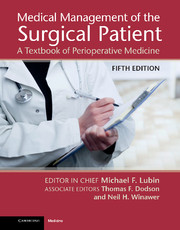Book contents
- Frontmatter
- Dedication
- Contents
- List of Contributors
- Preface
- Introduction
- Part 1 Perioperative Care of the Surgical Patient
- Part 2 Surgical Procedures and their Complications
- Section 17 General Surgery
- Section 18 Cardiothoracic Surgery
- Section 19 Vascular Surgery
- Section 20 Plastic and Reconstructive Surgery
- Section 21 Gynecologic Surgery
- Chapter 97 Abdominal hysterectomy
- Chapter 98 Vaginal hysterectomy
- Chapter 99 Uterine curettage
- Chapter 100 Radical hysterectomy
- Chapter 101 Vulvectomy
- Section 22 Neurologic Surgery
- Section 23 Ophthalmic Surgery
- Section 24 Orthopedic Surgery
- Section 25 Otolaryngologic Surgery
- Section 26 Urologic Surgery
- Index
- References
Chapter 100 - Radical hysterectomy
from Section 21 - Gynecologic Surgery
Published online by Cambridge University Press: 05 September 2013
- Frontmatter
- Dedication
- Contents
- List of Contributors
- Preface
- Introduction
- Part 1 Perioperative Care of the Surgical Patient
- Part 2 Surgical Procedures and their Complications
- Section 17 General Surgery
- Section 18 Cardiothoracic Surgery
- Section 19 Vascular Surgery
- Section 20 Plastic and Reconstructive Surgery
- Section 21 Gynecologic Surgery
- Chapter 97 Abdominal hysterectomy
- Chapter 98 Vaginal hysterectomy
- Chapter 99 Uterine curettage
- Chapter 100 Radical hysterectomy
- Chapter 101 Vulvectomy
- Section 22 Neurologic Surgery
- Section 23 Ophthalmic Surgery
- Section 24 Orthopedic Surgery
- Section 25 Otolaryngologic Surgery
- Section 26 Urologic Surgery
- Index
- References
Summary
Carcinoma of the uterine cervix is the second most common gynecologic malignancy worldwide and the third most common cause of cancer deaths in women all over the world. In 2010, an estimated 12,200 women in the USA were diagnosed with cervical cancer, and 4,210 women died from the disease.
Attempts to treat cervical cancer in the early nineteenth century were deemed largely unsuccessful due to the frequent occurrence of recurrent disease in the vaginal cuff. Surgeons such as Wertheim and Clark postulated that this was likely due to inadequate margin of excision. At the turn of the nineteenth century, these surgeons developed an operation that involved removal of the uterus, along with a wide resection of tissues around the involved cervical tumor.
The primary goal of radical hysterectomy is removal of the cervical tumor with a sufficient surgical margin. This entails removal of the uterus, cervix, superior vaginal margin, and parametrial tissue. Removal of the latter involves extensive dissection of the bladder, ureters, rectum, and lateral pelvic sidewalls.
Cervical cancer is staged clinically. All stages may be treated with a combination of radiotherapy and chemotherapy; however, early-stage cervical cancer may be treated with a radical hysterectomy. While microinvasive disease or stage IA1 can be adequately treated with a vaginal or simple abdominal hysterectomy, radical hysterectomy along with pelvic lymphadenectomy is utilized to treat stages IA2 through IIA. The overall survival of early-stage cervical cancer is similar between radical hysterectomy and radiotherapy. Therefore, patients who are poor surgical candidates due to severe medical illness or morbid obesity are probably best treated with primary radiotherapy.
- Type
- Chapter
- Information
- Medical Management of the Surgical PatientA Textbook of Perioperative Medicine, pp. 659 - 661Publisher: Cambridge University PressPrint publication year: 2013

